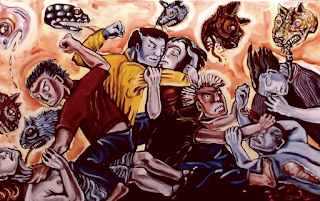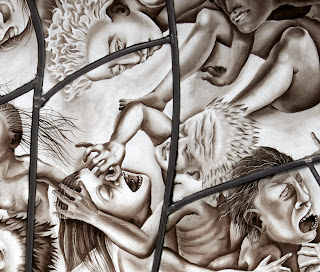 |
| This is what happens when an artist publicly declares they are moving away from human figure |
The journey towards making this piece began way before Covid and I did a previous post about it. In painstaking detail the post describes the journey of the drawing from cradle to grave. If you want to call the resolution of an artwork “the grave” and I find that I do. This piece is heavy on drawing so if you want to know more, please read the post here.
I also made a short video introducing the piece which you can watch if you would prefer. It will be based on the text below plus that previous post so you don’t need to read a single more word if you'd rather watch. Plus it will have even MORE info and pictures as its easier to talk than write.
Some context:
· I have always been fascinated by the following works of art:
“Raft of the Medusa” by Theodore Gericault, “Battle of the NakedMen”, 1465–1475 Antonio del Pollaiuolo.
· I have done “battle scenes” since I was a painting major in 1981.
· I have an urge to depict “piles of things” or interlocking things.
· Perhaps related to that urge, is a strong urge to do repeating, tessellated patterns.
· I think Escher is an under-rated artist. Seriously.
· Swearing off figures makes it into an irresistible forbidden fruit.
· The summer of 2020.
That’s the brain brew that grew “Raft of the Medusa”.
As for the narrative content…i.e. “subject matter”: First off, a caveat. In discussing, analyzing or critiquing art, the urge to understand “subject matter” or “narrative content” as somehow separate from design and material concerns HAS GOT TO STOP……she said, possibly rushing forward right into that very trap…. Subject matter alone is not “Concept”. “Concept” is not a synonym for meaning…just stop it people, would you?? The meaning of a work of art is in its gestalt—the experience of its subject/design/material all play integral parts, and all generate aspects of meaning.“Raft of the Medusa” was a very direct attempt to come to terms with the very traumatic summer of 2020. This time period, I know you haven’t forgotten and won’t for a long time, was marked by social isolation from covid and social unrest from Black Lives Matter protests. To crowd or not to crowd...that was the question or for many, it became worth it to demonstrate that some issues are worth risking death for, so demonstrate some people did.
Donald Trump and his policies, administration etc. filled me (and many, many artists) with the urge to say something. Why is it so hard to get along? I think we do want to love one another, but it’s so very, very difficult. Even loving a single other person is a difficult task that involves facing one’s own shadow self, let alone trying to love human-kind as a clump. And loving neighbors…well loving thy neighbor is probably the hardest thing to ask in the whole world! How can I possibly when they are hoarders who smoke? Or vote differently or have different beliefs?
I have always thought that disapproving of one’s “neighbors” (i.e. “others”) is not really about them anyway, but about coming to terms with the parts of ourselves that are most hard to reconcile, to love. Being angry with your “neighbor” is the single most effective strategy to avoid recognizing the parts of yourself you hate! But that’s because it’s easy: they are, almost by definition, strange and alien and you can consolidate your love for your family and friends at their expense, without threat. I mean that without a ton of judgment—it’s kind of our default setting and hard to change.
Last summer, even die-hard soft-hearted liberals were unfriending their neighbors and families on Facebook over social policy disagreements. And all this played out with a deadly pandemic urging us to ISOLATE! HIDE! Duck and cover…. We have met the enemy and he is virus-us.
Covid brought all this out, it’s not a coincidence it all happened at once.
I hope this isn’t too moralistic and preachy—I don’t want to tell people how to think. Just, perhaps make mild suggestions.
SO, I made a picture, which, I hope, expresses and externalizes the all-too-human struggle to deal with our fear and aggression towards others, our loved ones and ultimately our own selves. It’s all the same fear. That which I imagine to be outside of myself is always within and to come to terms with that is the essence of love.
In the image, I included a lot of people struggling and writhing in discomfort and dis-ease, together and alone and there all stuck together on this tiny “raft” (not pictured!) and there are even some moments of tenderness if you look for them.
____________________________________________________________________________________
 |
| Painting in progress |
Design Concerns:
I have an urge to depict “piles of things” or interlocking things. What is this about?
Despite the contemporary pressure for an artist to analyze themselves to death I am going to attempt to reclaim the following: “my work is an attempt to know myself and by extension to understand other and the entire world outside of my brain. Any claims of a-priori conclusion would be absurdly premature. In other words, I work intuitively and am utterly in service to my subconscious. And although they (i.e. neurologists) will never locate a “collective subconscious” in the brain, its metaphorically true enough. Suck it up, buttercup!” I hope you enjoyed that bit of art-speak for “no clue.”
Perhaps related to that urge, is a strong urge to do repeating, tessellated patterns. Also “no clue”—but I would suggest that much of what a brain wants to do is draw pictures of itself and often that self is strangely mathematical. I read somewhere (and I deeply regret I can’t remember where) that many of their abstract doodlings a person is compelled to do resemble nothing so much as biological phenomena such as phosphenes. Who knows what we will figure out in terms of how the brain encodes self-generated images in the future. I look forward to whatever it is.
Super bonus! I also made a tiny version of this for Shelter in Place Gallery:
 |
| tiny! |
 |
| The gallery is a perfect scale model and my piece appears to be gigantic! |












1 comment:
I am impressed by you and your art. You have the mind, vocabulary, and the ability to express yourself and say something in a material that few people expect, in your face strength and honesty. At one time I believe artists had dialogues about ART that included the times they were living, the manner in which they expressed themselves, they even god forbid criticized the work of other artists. One would think with all the social media available and how electronically connected we are communication would be flourishing in the arts. Thank you Judith for your art and intelligence. Oh, and not being afraid to put yourself out there. dh
Post a Comment